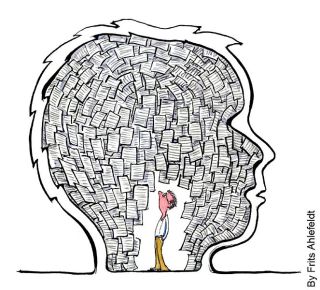Personality
Flashes of Personality Reward Readers
You reveal your ethos and personality in your writing.
Updated October 30, 2023 Reviewed by Michelle Quirk
Key points
- People can detect your personality, character strengths, and psychology from samples of your writing.
- You reveal the "big five" traits—openness, conscientiousness, extraversion, agreeableness, and neuroticism.
- Showing personality appeals to people’s desire for social connection, a reward-filled human drive.
With each passing year, psychologists are figuring out more and more about who you are from what you write. When you post on social media, email a friend, or draft a memo, you reveal a lot about your “big five” personality traits—conscientiousness, extraversion, openness to experience, agreeableness, and neuroticism.1
What’s more, the people who read your work thirst to detect who you are.2 In 2010, Albrecht Küfner and a team at Johannes Gutenberg University Mainz (Germany) tested just how much. They asked 79 people to spend seven minutes writing fictional stories. Each story had to include the words ‘‘plane crash,” ‘‘parlor maid,” ‘‘fireworks,” ‘‘Middle Ages,” and ‘‘supermarket.”3

Afterward, the readers rated each author’s personality traits, which had been measured earlier. They also rated the authors’ “general knowledge.” The results? The readers correctly judged the authors’ openness, agreeableness, and general knowledge, although they didn’t score well on neuroticism, extraversion, or conscientiousness.
Küfner and his team could conclude: “Writing and personality go hand in hand. Independent of whether the author is writing a novel, a diary, a ...message or a blog.”
Readers Want the Real You
Of what use is this if you’re a writer? Research shows that writing in a way that allows readers to understand who you are rewards readers.4 In other words, allowing readers to connect with you socially—by making your personality transparent—offers a potent way to boost your impact as a writer.
Research today using AI suggests that your writing reveals more about you than you probably think.5 Majid Ramezani and colleagues at the University of Tabriz, Iran, used techniques in 2022 that allowed them to detect all five of the personality traits with more than 70 percent accuracy.6 They did so from analyzing just one sample essay from each author.
Other researchers, tapping big social media datasets, have gone further. Dandan Pang at the University of Bern and a team largely at the University of Pennsylvania correlated words used in tweets with people’s 24 character strengths. They found that they could predict all 24 strengths.
Examples of strengths include gratitude, leadership, social intelligence, teamwork, curiosity, and love of learning.7 Dandan’s team found that words correlated with teamwork, for example, included “good,” “great,” “best,” “first,” “c’mon,” “congrats,” and “future.” Those correlating with gratitude included “so grateful for,” “blessed,” “impressive,” “amazing,” and “congrats.”
Words Reveal Psychology
Other researchers have refined the detection of your psychology yet more. A team led by David Yaden at Johns Hopkins showed they could tease apart the difference between empathy and compassion, two often conflated psychological processes, in people’s Facebook posts.
Analyzing 2,356,916 posts from 2,781 people, they found that when you express high compassion versus high empathy, you often use words like “you,” “we,” “love,” “family,” “god,” “thank you,” “good,” and “happy.” If you express high empathy versus compassion, you often use words like “I,” “my,” “myself,” “feel,” “miss,” “much,” “but,” and “gonna.”8
Yaden and his team maintain that the difference derives from the distinction between empathy and compassion. Empathy, they say, is “self-focused.” When you’re empathetic, you internalize others’ woe and psychological misfortune. Compassion is “other-focused.” When you’re compassionate, you keep others’ mental and physical misfortune and feelings front of mind, but not internalized.
They found that the mental health of the people using the two kinds of language diverged sharply. Highly empathetic people often wrote about negative feelings, social isolation, and feeling overwhelmed. Highly compassionate ones wrote about positive feelings and social connections.
Transparency Rewards
How do these findings help you to better engage readers? Aristotle argued that persuasive writing has three hooks: logos (logic), pathos (emotion), and ethos (who you are as an author). Most writers focus on logos and pathos. But your ethos, when you reveal it, gives you an added means to come across persuasively.
You might worry about your privacy. But, in today’s world, an app that allows strangers to read your psychology just from examining your social media posts is probably on its way. Some scientists argue that the capability to instantly analyze your psychology could help improve relationships. It also could aid corporate recruiters, online marketers, and others in doing their work.9
However you feel about this new reality, you do have some control over how transparent you make your inner self. You also can benefit from being open. Readers more eagerly consume words of authors they can connect with socially. They sense and can be engaged by your authenticity.
You can vary how much of yourself to put on display. Try modulating your writer’s voice and the tone of your opinions. Or calibrate how much you reveal your intentions, goals, and vulnerabilities to convey the ethos that reflects the real you. You could seek anonymity. Limiting yourself to antiseptic words, phrasings, and content would hide your inner thinking. But then you would deprive yourself of a powerful means to increase your impact.
References
1. For two meta-analyses, see José David Moreno et al., "Can Personality Traits Be Measured Analyzing Written Language? A Meta-Analytic Study on Computational Methods," Personality and Individual Differences 177 (2021). See also, Antonis Koutsoumpis et al., "The Kernel of Truth in Text-Based Personality Assessment: A Meta-Analysis of the Relations between the Big Five and the Linguistic Inquiry and Word Count (Liwc)," Psychological Bulletin 148, no. 11–12 (2022).
2. As just one recent article on this subject, known as “theory of mind,” see Miriam E Weaverdyck, Mark A Thornton, and Diana I Tamir, "The Representational Structure of Mental States Generalizes across Target People and Stimulus Modalities," NeuroImage 238 (2021).
3. Albrecht CP Küfner, Mitja D Back, Steffen Nestler, and Boris Egloff, "Tell Me a Story and I Will Tell You Who You Are! Lens Model Analyses of Personality and Creative Writing," Journal of Research in Personality 44, no. 4 (2010).
4. Jamil P. Bhanji and Mauricio R. Delgado, "The Social Brain and Reward: Social Information Processing in the Human Striatum," Wiley Interdisciplinary Reviews. Cognitive Science 5, no. 1 (2014).
5. For example, see Gregory Park et al., "Automatic Personality Assessment through Social Media Language," Journal of Personality and Social Psychology 108, no. 6 (2015).
6. Majid Ramezani, Mohammad-Reza Feizi-Derakhshi, and Mohammad-Ali Balafar, "Text-Based Automatic Personality Prediction Using Kgrat-Net: A Knowledge Graph Attention Network Classifier," Scientific Reports 12, no. 1 (2022).
7. Dandan Pang et al., "The Language of Character Strengths: Predicting Morally Valued Traits on Social Media," Journal of Personality 88, no. 2 (2020).
8. David B Yaden et al., "Characterizing Empathy and Compassion Using Computational Linguistic Analysis," Emotion (2023).
9. Ramezani, Feizi-Derakhshi, and Balafar, "Text-Based Automatic Personality Prediction Using Kgrat-Net: A Knowledge Graph Attention Network Classifier."




